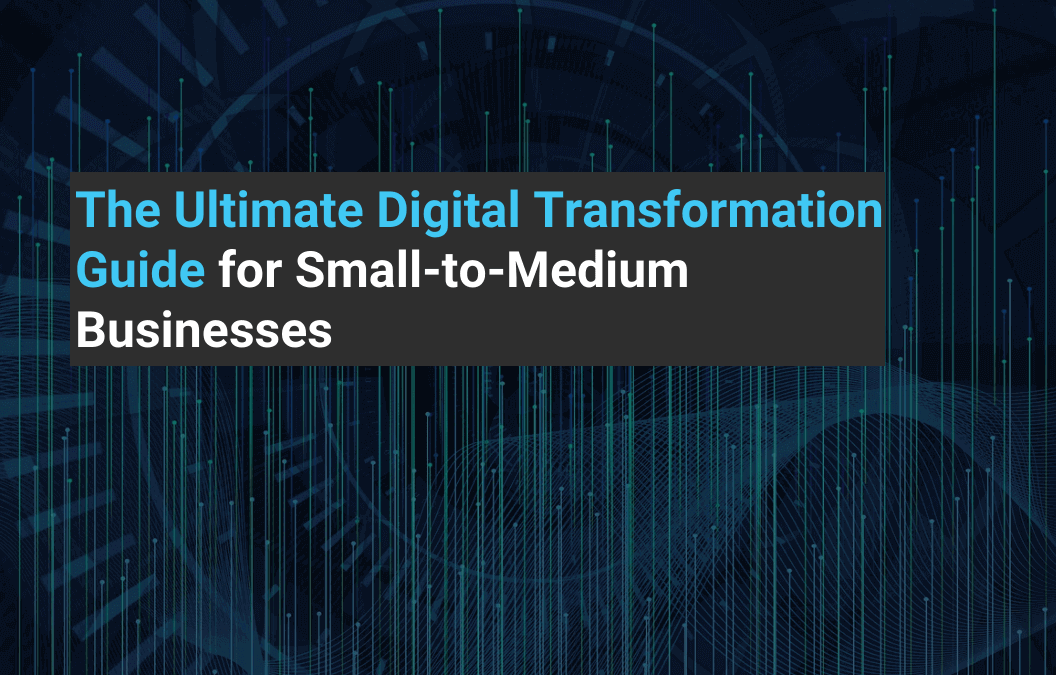Business is constantly reshaped by the forces of technology.
For many small-to-medium businesses (SMBs), digital transformation isn’t just a buzzword; it’s a critical investment into their future competitiveness and growth.
For a start, it involves rethinking your operations, from customer interactions to internal processes. it also involves harnessing the power of new digital tools to improve efficiency, engagement, and ultimately, profitability.
This guide offers a walkthrough for SMBs to understand what digital transformation entails, why it’s so important, and how to navigate it effectively.
This guide will show you that digital transformation is less about any single technology, and more about a holistic strategy tailored to your unique business needs.
Whether you’re looking to refine customer experience, streamline operations, or unlock new avenues for innovation, this guide is your starting point for turning digital potential into tangible business success.

What is Digital Transformation?
In the evolving business landscape, digital transformation has emerged as the cornerstone of modern enterprises.
It’s important to think of it as more than just adopting new technologies; it’s a revolution in the very fabric of your business operations. This transformation redefines how organisations manage resources, engage with customers, and deliver value across all touchpoints.
Digital Transformation Definition
Digital transformation encapsulates the integration of digital technology into every business sphere, fundamentally altering operations and customer value delivery. It embodies a shift in corporate culture, encouraging organisations to veer from the beaten path, foster innovation, and embrace the learning curve that comes with change.
“Digital transformation is the integration of digital technology into all areas of a business, fundamentally changing how you operate and deliver value to customers. It’s also a cultural change that requires organizations to continually challenge the status quo, experiment, and get comfortable with failure.”
The Enterprises Project
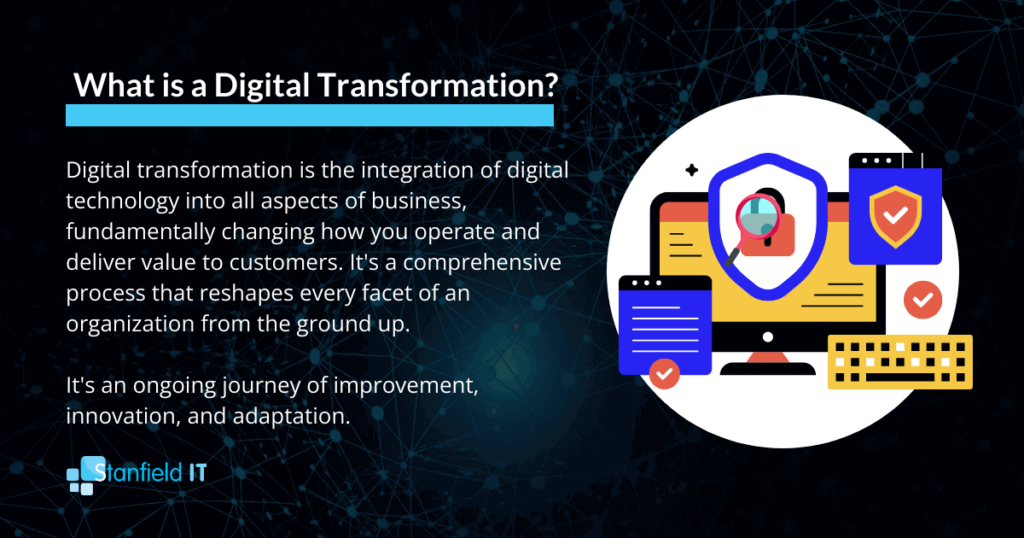
This change varies by enterprise; its impact is ubiquitous across sectors.
It’s important for business leaders to navigate this technological terrain, discerning which emerging technologies can catalyse their company’s evolution.

Research by McKinsey & Company underscores a pivotal insight: breadth in digital initiatives correlates with transformation success.
For small businesses, this is particularly promising.
Data indicates that organisations with fewer than 100 employees are 2.7 times more likely to report successful digital transformation than their larger counterparts.
Small scale can be your strategic leverage.
“Digital transformation marks a radical rethinking of how an organization uses technology, people and processes to fundamentally change business performance.”
George Westerman, MIT principal research scientist and author of Leading Digital: Turning Technology Into Business Transformation.
In essence, digital transformation for small and medium businesses isn’t just about survival in the digital era – it’s about thriving, capitalising on agility, and turning technology into a strategic advantage.
Digital Transformation Journey― how did we get here?
Before we dive into how you can intelligently transform your small-to-medium business, let’s look at how we went from paper and pencil to hard drives and the Cloud.
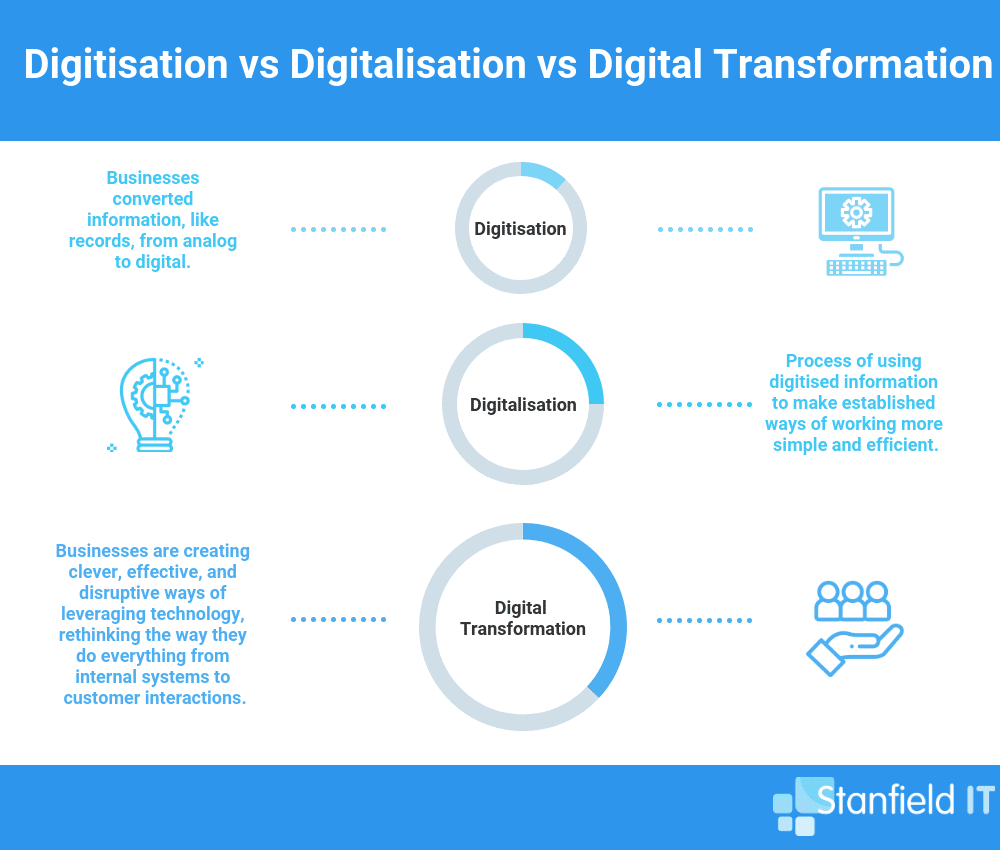
Although it may be unimaginable today, it wasn’t actually very long ago that records were kept on paper―first, handwritten, and then typed into documents. You had to deal with these physical documents―paper, binders, xeroxes, faxes―if you wanted to gain, share, or source information (you’re giving the Cloud a virtual hug now, aren’t you?). Computers then went mainstream and businesses started converting their files. Finding and sharing information was now much easier, but methods were nowhere near peak efficiency, as the way businesses used digital records to find, share, and use information was built on analog-era methods.
The process of digitalisation used new digital ways of working to simplify processes, turning away from outdated analog methods that didn’t mesh with the new systems. Digitalisation centres around working quickly and more efficiently—hopefully, with a more polished end result, too—taking advantage of the data you need being right at your fingertips. With this digital workplace evolution came a whirlwind of ideas for using business technology in different ways.
Enter, digital transformation!
Suddenly, new technologies, new things—plus new ways of doing them—were possible for our small-to-medium Australian business. As well as promoting new, innovative, customer-centric ways of doing thigs, digital transformation has added other value to businesses: prompting them to revisit everything they do and how they do it. This lets managers and other stakeholders identify how processes can enable better decision making, sizeable efficiency increases, and more personalisation for customer and client engagement. Digital transformation has seen countless small, medium, and large businesses leveraging new technology in smart new ways that reinforce their business goals and overarching objectives as a company.
The Anatomy of Digital Transformation
Why does digital transformation matter?
In a world where change is the only constant, business leaders – from garage start-ups to established CEOs – are the catalysts for digital transformation.
It’s crucial for small-to-medium business owners to recognise that embracing digital change is not reserved for the tech giants. It’s a universal business imperative, regardless of size or industry.
Drives data-based insights
Digital transformation unlocks the power of data analytics, allowing businesses to uncover hidden insights and refine their strategies.
By leveraging both structured and unstructured data, companies gain a deeper understanding of customer behaviours and preferences. This leads to personalised experiences and real-time responsiveness that will drive growth and innovation.
Skill development and knowledge expansion
As digital technologies evolve, so does the need for specialised skill sets.
It’s essential for businesses to invest in their employees’ continuous learning, cultivating a workforce equipped with the skills to thrive in a digital future.
Recognising this investment as driver of your competitive advantage rather than a mere cost is critical for sustainable growth.
Fosters digital-first culture
The transition to a digital-first business is as much about culture as it is about technology.
A flexible, adaptable workplace culture that supports change is fundamental. It’s not enough to adopt new technologies; your business must also foster an environment of continuous learning and collaboration.
You want to align your team members with the vision of digital excellence.
Streamlining operations through technology
Technology has revolutionised how businesses connect with stakeholders and manage workflows.
Digital tools – from social media to project management software – integrate business functions, enhancing communication and operational efficiency.
This consolidation not only reduces overhead costs but also aligns with the modern customer’s expectations for seamless digital interactions.
Unifying the workforce
Digital transformation bridges the gap between disparate teams, fostering unity and collaborative work practices. Tools like Microsoft Teams and OneDrive facilitate natural collaboration, allowing team members to stay connected irrespective of location.
Platforms like Trello enable collective goal-setting and process tracking, nurturing an inclusive and productive digital work environment.
Digital Transformation Trends
The world of digital transformation is always evolving. And it will continue to shape the future of business operations and competitive advantage.
There are several key trends setting the stage for the next wave of digital transformation. Let’s look at a few.
Past/ongoing digital transformation trends
IoT integration and intelligence
The Internet of Things (IoT) has evolved into a sophisticated network that integrates advanced analytics, sensor technology, and edge computing.
Real time date analysis derived from IoT is now pivotal for strategic business decisions, optimising operations, and enhancing customer experiences.
Embracing agile operations
If you want your business to stay ahead, you need to be agile.
Companies are leveraging digital tools to rapidly adapt to market changes, streamline product development, and efficiently allocate resources.
Blockchain beyond hype
Blockchain technology is finding its footing with practical applications that extend beyond cryptocurrencies.
Its capabilities are being harnessed to bolster supply chain integrity, enhance transactional security, and streamline regulatory compliance processes.
More and more we’re seeing blockchain technology demonstrate its value in a variety of business contexts.
AI and Machine Learning: driving business innovation
Artificial Intelligence (AI) and Machine Learning (ML) are at the forefront of a major shift in how businesses operate and compete. These technologies are not just about automating routine tasks; they’re about reimagining the possibilities of business intelligence, customer interaction, and operational efficiency.
AI systems are now capable of analysing large datasets to identify patterns, predict outcomes, and make decisions with little to no human intervention. So what? Well, it allows businesses to anticipate market trends, tailor customer experiences, and optimise supply chains in ways that were previously impossible.
Businesses are also using AI to improve customer service through advanced chatbots and virtual assistants. While they’re often not perfect, they can handle a wide range of customer inquiries with immediacy and precisions. This is especially valuable for businesses with a lot of inbound. These AI driven interfaces are continually learning from interactions to provide better service, driving customer satisfaction and loyalty.
Moreover, AI and ML are catalysing the development of new products and services. For instance, in healthcare, AI algorithms can analyse medical images for diagnostics, while in finance, ML models are used for real-time fraud detection.
Investments in AI and ML are not just for large corporations; SMBs can also leverage these technologies to level the playing field. By adopting AI and ML, SMBs can gain insights into customer behaviour, streamline operations, and create innovative offerings that differentiate them in the marketplace.
As AI and ML technologies become more accessible and cost-effective, their adoption is expected to accelerate, becoming an integral part of the digital transformation journey for businesses of all sizes.
Data management in the cloud
The shift to cloud computing has brought intelligent data management to the front line. AI-driven solutions are now essential for managing complex IT ecosystems, with automation playing a key role in ensuring efficiency and reducing margin for error.
The norm of multi-cloud strategies
Multi-cloud and hybrid cloud strategies have become standard as businesses seek to optimise their IT infrastructure. Robust security measures are integral to these strategies, ensuring data protection and compliance in an increasingly cloud-centric world.
Edge computing’s critical role
Edge computing is crucial for processing data where it’s generated. With the rise of IoT devices, edge computing is facilitating low-latency applications and is instrumental in areas requiring immediate data analysis, such as smart cities and industrial automation.
5G: enabling advanced connectivity
The advent of 5G networks is revolutionising connectivity, with significant benefits for businesses.
Enhanced bandwidth and lower latency are catalysing the growth of IoT and enabling new mobile services, creating opportunities for innovation across various industries.
Your Small-to-Medium Business’s Biggest Digital Transformation Assets
For small-to-medium businesses (SMBs), digital transformation opens a realm of opportunities, offering growth and innovation potential on par with larger enterprises but with the agility that comes form their size.
Maximising your website’s potential
Your website is often your first point of contact with customers. It’s your digital billboard, working 24/7.
It should embody your brand, articulate your value proposition, and ensure an excellent user experience.
Investing in a robust, mobile responsive website can pay dividends in customer acquisition and retention. Consider if your website truly represents your business values and if it’s designed to not just inform but to convert visitors into customers.
Leveraging a cohesive team
SMBs can adopt digital transformation more nimbly, thanks to smaller, more connected teams. Ensure that every team member is aligned with digital changes, understanding how these will streamline their work and contribute to the company’s growth.
Engage with your team to foster a digital-first mindset that embraces change as a constant and sees technology as an enabler rather than a disruptor.
Embracing business agility
Flexibility and adaptability are inherent strengths of SMBs.
These qualities are invaluable as customer engagement shifts from traditional methods to digital channels like social media, content marketing, and mobile outreach.
It’s not enough to simply have a presence on these platforms, the key is to use them strategically enhance customer engagement and rive business results.
Recognising your business potential
Understanding the unique position your SMB holds in the market and harness digital tools to capitalise on this. Digital transformation isn’t a trend; its a strategic imperative to unlock new ways to serve customers better, streamline operations, and differentiate your business in the digital marketplace.
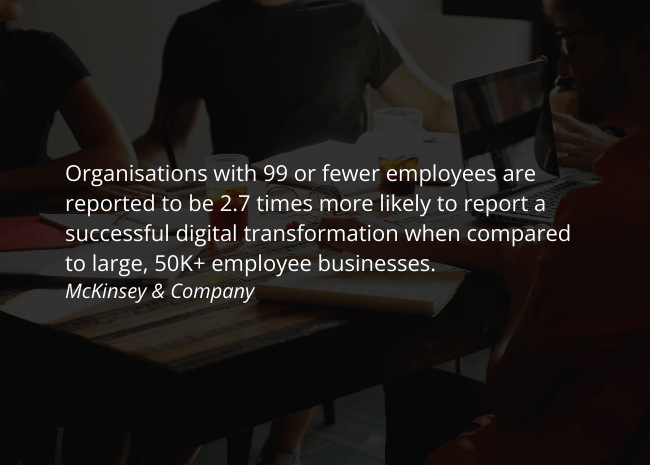
Digital Transformation Strategy
A well crafted digital transformation strategy is the bedrock of successful adaptation. It’s less about perfection on the first attempt and more about adaptability and continuous improvement.
Digital transformation will look differently on every company, so don’t get too preoccupied comparing your efforts to other businesses in your industry or region. Beyond fundamental changes to business operations and delivering value to customers, digital transformation is:
“A cultural change that requires organizations to continually challenge the status quo, experiment often, and get comfortable with failure.”
The Enterprises Project
Crafting your digital narrative
Begin by defining what digital transformation means for your company.
Clarify how this shift will impact daily operations and communicate this vision clearly across the organisation. Ensure that every employee understands their role in this transformation, particularly as it pertains to the adoption of cloud technologies.
Demystify tech jargon by linking it directly to the benefits and changes in workflow that your team can expect.
Alignment with business objectives
Digital transformation should be a thread woven through every department, aligning with and propelling the business’s overarching goals.
This alignment ensures that digital initiatives enhance rather than disrupt business processes, and helps secure buy-in from all levels of the organisation.
Testing and adapting
Pilot programs and phased rollouts can help can help gauge effectiveness of digital changes and identify potential stumbling blocks.
In smaller businesses, where changes can be implemented more swiftly, this approach allows for quick feedback and agile responses.
Skill acquisition and development
Understanding the skills necessary for your digital transformation is crucial. Consider partnering with IT specialists, like Stanfield IT, who can bring a wealth of expertise to your business, ensuring you have the right mix of skills and knowledge for a smooth transition.
Ask yourself: What people do we need? What skills need developing? Are we lacking any competencies?
“We retooled the IT department to move away from some of the commodity skills to more forward-looking capabilities that align with our strategy. In addition, we have an ongoing need to build competencies that augment our skills, especially around business acumen. You may be the best UX person around, but if you aren’t competent with your business acumen, you won’t be successful.”
James Swanson, CIO and head of digital transformation at Bayer Crop Science
Use technologies that add business value
Choose technologies that provide tangible benefits to your business rather than chasing trends. Successful businesses tie innovation to their strategic vision, enabling employees to experiment and learn within a supportive framework.
You should aim to set parameters around digital transformation so that you can continually test hypotheses, gain actionable learnings, and either adapt or discard experiments along the way. Businesses that do this well link their innovation to their big-picture vision, make experimenting simple for their employees, and disperse responsibilities amongst everyone with a role in the digital transformation.
Proactive risk management
The disruption digital transformation can bring, and change to business models, may appear to go against traditional IT concepts of risk containment and controls.
With digital transformation, you move quickly, challenge the status quo, and scale new technologies (bringing about different mindsets, too). Barry Brunsman, principal with KPMG’s CIO Advisory, says these very characteristics demand the diligent design of risk management and controls around the digital transformation effort. He explains that CIOs who have mastered this aspect of disruptive change are more likely to be managing a successful transformation program―this is also relevant to digital transformation in small-to-medium businesses.
Embracing cultural evolution
A successful digital transformation is as much about technology as it is about people.
Cultivate a culture that is open to change, willing to take risks, and can learn from setbacks.
You must make sure that you have the right culture to adopt change and adapt to it. Your team needs to be board with the processes and prepared to accept risk and tolerate failure. Overlooked cultural change implications has been said to be one of the biggest reasons that digital transformation fails, as, no matter how great the technology, employees who won’t accept new ways of working will dictate how successfully technologies are used in the business. Deal with any concerns prior to rollout, so that employees don’t feel like they’re just being thrown in the deep end and their views aren’t valued.
Digital Disruption as a result of Digital Transformation in your Business
Digital disruption occurs when emerging technologies and innovative business models significantly alter the landscape of products and services. The widespread adoption of mobile devices – a trend known as the consumerisation of IT – has accelerated the potential for digital disruption across various industries, reshaping how businesses operate and deliver value to customers.
Disruption is fuelled by changes in several external factors, including:
- Customer expectations: Today’s consumers demand more personalised and on-demand services, forcing companies to rethink their customer engagement strategies.
- Employee expectations: The modern workforce expected flexible, technologically-advanced work environments that foster innovation and personal growth.
- Technological advancements: The rapid pace of technological innovation continually expands what is possible, pushing companies to adapt or risk becoming obsolete.
- Emerging commercial models: New business models are disrupting traditional markets, emphasising the needs for companies to innovate their revenue streams.
- Effective strategies: As the business landscape shifts, strategies that once guaranteed success may no longer be effective, necessitating a strategic pivot.
No company is immune to the challenges and learning curves that accompany digital disruption. Recognising potential problems early on is crucial for successful navigation through these transformative times.
Anticipating the impact of digital disruption on your business
Digital disruption typically occurs post-implementation of digital innovations rather than during the adoption phase. As businesses incorporate new technologies they inadvertently shift customer and client expectations.
This shift necessitates a revaluation of product creation, marketing engagement strategies, and feedback mechanisms.
It’s crucial to differentiate between genuine digital disruption and the buzzwords that often cloud its meaning. Digital disruption is not merely the inclusion of digital technology in a product or using digital means to outpace competitors. It is distinct from ‘disruptive technology’, a term coined by Clayton M. Christensen, which refers to innovation that entirely displaces existing technologies.
True digital disruption can be observed in the major industry shifts of recent years, reshaping not just individual companies but entire markets and societal practices.
Embracing digital disruption as a catalyst for growth
Digital disruption need not be daunting; it can be a powerful force for progress.
It’s essential for businesses to lean into the winds of digital change to maintain relevance and sharpen their competitive edge. When industries are disrupted digitally, it often signals a shift in consumer needs – a valuable insight for businesses aiming to stay in tune with their market.
Understanding that digital disruption can help maintain customer satisfaction and pave the way for attracting new clientele is crucial. It also provided businesses with a deeper understanding of their target audience’s behaviours and the likely progression of market trends over time. To turn digital disruptions into opportunities rather than threats, businesses should:
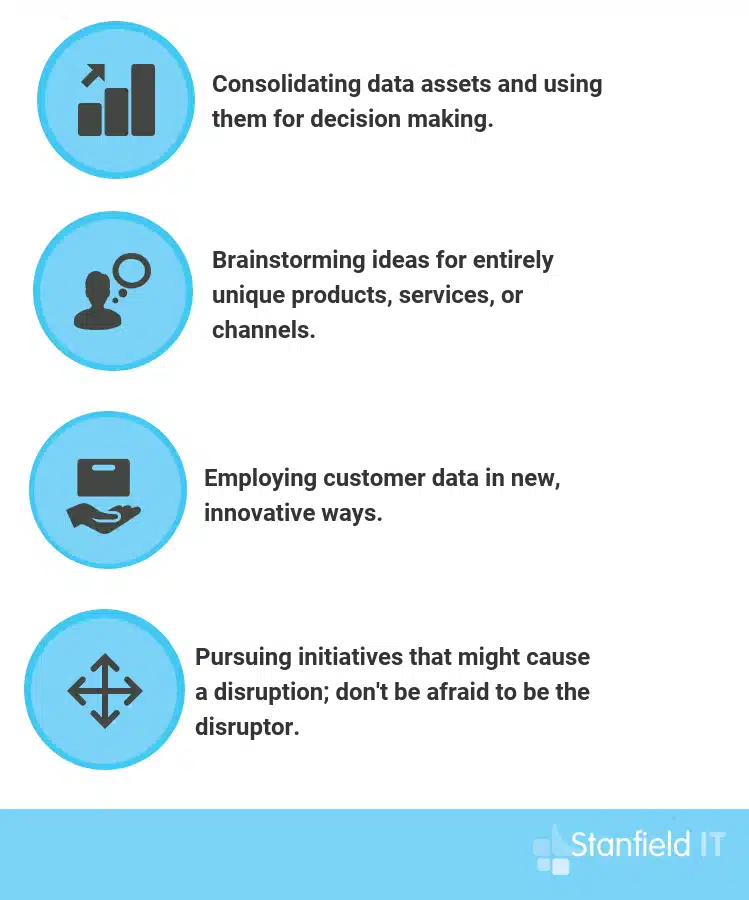
By ensuring digital disruptions are seen as a chance for growth, businesses can use them to their advantage.
Frameworks for Digital Transformation in Business
What is a digital transformation framework?
We’ve learnt how digital transformation comes as a result of changes and brings a lot of change with it itself. A digital transformation framework is a blueprint that can assist you when moving through these changes. It provides a set plan and goals—stopping you from veering off course.
A proper, effective framework will guide all levels of the organisation through the digital transformation journey and ensure all areas of the business are attended to through the change, leaving no areas misunderstood. This may sound like it’s tailored to larger, enterprise-sized businesses, but a framework can work for a business of any size—they’re versatile and can be made from the ground up just for you. Acting as a common reference point—that can easily be amended as changes evolve—a digital transformation framework can often be the key to success. Organisations of all sizes can use their framework to enable the strategy and road-map needed to best tackle rapidly changing market conditions.
How to choose the right digital transformation framework
Selecting an adaptable digital transformation framework is essential for any business. It should offer clear, logical steps to guide progress and identify challenges, beginning with a strong foundation and evolving through strategic phases.
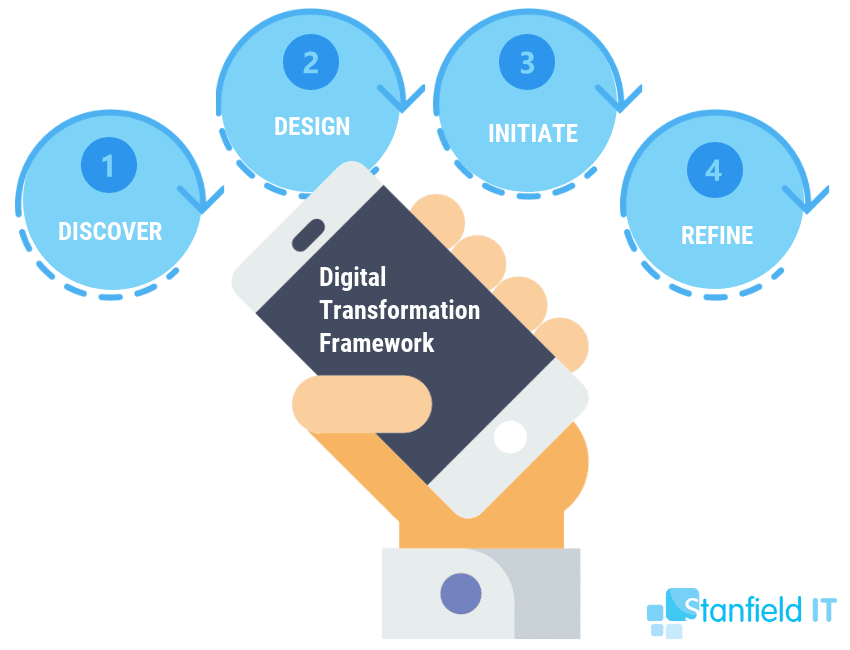
1. Discover Phase
Your vision for the company’s future should be clear, encompassing staff, customers, and market dynamics. Change should not be reactionary but intentional. You want a defined purpose understood by all stakeholders. Use internal insights to shape the outcomes you seek through transformation.
2. Design Phase
Leadership is critical in crafting your framework.
Define roles, delegate responsibilities, and ensure organisational support. Include comprehensive market analysis and assessments of current business state to inform your desired outcomes. Establish metrics that define success and guide change implementation.
Remember, the approach to change is as critical as the change itself.
3. Initiation Phase
A unified framework language helps align expectations and consolidate goals.
Organise your transformation efforts into distinct streams, such as people, customers, processes, products, and technology. Embed your business culture within the framework, preparing it to evolve with the changes. Allocate time for communication and education, like workshops, to discuss the upcoming transformations.
4. Refinement Phase
Continuously evaluate progress against benchmarks, allowing for adjustments as needed. Change in benchmarks reflects the evolving nature of the transformation, not a deviation from goals. Pivots, informed by ongoing assessments, should be seen as opportunities to steer towards the most effective outcomes.
Your digital transformation framework is the compass that guides you through the transformative process. In times of significant change, it serves as a touchstone to realign with your business objectives.
Conclusion
If you’re contemplating whether digital transformation is essential for your business, consider this: In today’s economy, a deep connection with clients, highly engaged employees, and cutting-edge technology aren’t just nice-to-haves; they’re the backbone of innovation and competitive advantage.
Digital transformation isn’t industry specific. It’s a universal imperative in an era of slim margins, fierce competition, and elevated customer and employee expectations. You may already be n this journey, perhaps without a formal strategy. Yet, it’s never too late to refine your approach, adopt a structured framework, and ensure that every team alignment with transformation objectives.
While the road to digital transformation is intricate and extends beyond a checklist, there are opportunities for growth and efficiency. With a partner like Stanfield IT, you’re equipped not just to face the challenge but to turn it into your business’s triumph.
